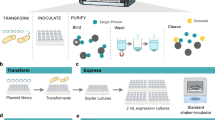Abstract
Affinity purification of recombinant proteins has become the method of choice to obtain good quantities and qualities of proteins for a variety of downstream biochemical applications. While manual or FPLC-assisted purification techniques are generally time-consuming and labor-intensive, the advent of high-throughput technologies and liquid handling robotics has simplified and accelerated this process significantly. Additionally, without the human factor as a potential source of error, automated purification protocols allow for the generation of large numbers of proteins simultaneously and under directly comparable conditions. The delivered material is ideal for activity comparisons of different variants of the same protein. Here, we present our strategy for the simultaneous purification of up to 24 affinity-tagged proteins for activity measurements in biochemical assays. The protocol described is suitable for the scale typically required in individual research laboratories.
Access this chapter
Tax calculation will be finalised at checkout
Purchases are for personal use only
Similar content being viewed by others
References
Young CL, Britton ZT, Robinson AS (2012) Recombinant protein expression and purification: a comprehensive review of affinity tags and microbial applications. Biotechnol J 7:620–634
Smith DB, Johnson KS (1988) Single-step purification of polypeptides expressed in Escherichia coli as fusions with glutathione S-transferase. Gene 67:31–40
Janknecht R, de Martynoff G, Lou J, Hipskind RA, Nordheim A, Stunnenberg HG (1991) Rapid and efficient purification of native histidine-tagged protein expressed by recombinant vaccinia virus. Proc Natl Acad Sci U S A 88:8972–8976
Chaga GS (2001) Twenty-five years of immobilized metal ion affinity chromatography: past, present and future. J Biochem Biophys Methods 49:313–334
Hefti MH, Vugt-Van V, der Toorn CJ, Dixon R, Vervoort J (2001) A novel purification method for histidine-tagged proteins containing a thrombin cleavage site. Anal Biochem 295:180–185
Wiesler SC, Weinzierl RO (2011) The linker domain of basal transcription factor TFIIB controls distinct recruitment and transcription stimulation functions. Nucleic Acids Res 39:464–474
Nottebaum S, Tan L, Trzaska D, Carney HC, Weinzierl RO (2008) The RNA polymerase factory: a robotic in vitro assembly platform for high-throughput production of recombinant protein complexes. Nucleic Acids Res 36:245–252
Tan L, Wiesler S, Trzaska D, Carney HC, Weinzierl RO (2008) Bridge helix and trigger loop perturbations generate superactive RNA polymerases. J Biol 7:40
Weinzierl RO (2013) The RNA polymerase factory and archaeal transcription. Chem Rev 113:8350–8376
Frenzel A, Bergemann C, Köhl G, Reinard T (2003) Novel purification system for 6xHis-tagged proteins by magnetic affinity separation. J Chromatogr B Analyt Technol Biomed Life Sci 793:325–329
Wiesler SC, Weinzierl RO (2012) High-throughput purification of affinity-tagged recombinant proteins. J Vis Exp 66:e4110
Camara B, Liu M, Reynolds J, Shadrin A, Liu B, Kwok K, Simpson P, Weinzierl RO, Severinov K, Cota E, Matthews S, Wigneshweraraj SR (2010) T7 phage protein Gp2 inhibits the Escherichia coli RNA polymerase by antagonizing stable DNA strand separation near the transcription start site. Proc Natl Acad Sci U S A 107:2247–2252
Author information
Authors and Affiliations
Corresponding author
Editor information
Editors and Affiliations
Rights and permissions
Copyright information
© 2015 Springer Science+Business Media New York
About this protocol
Cite this protocol
Wiesler, S.C., Weinzierl, R.O.J. (2015). Robotic High-Throughput Purification of Affinity-Tagged Recombinant Proteins. In: Reichelt, S. (eds) Affinity Chromatography. Methods in Molecular Biology, vol 1286. Humana Press, New York, NY. https://doi.org/10.1007/978-1-4939-2447-9_9
Download citation
DOI: https://doi.org/10.1007/978-1-4939-2447-9_9
Publisher Name: Humana Press, New York, NY
Print ISBN: 978-1-4939-2446-2
Online ISBN: 978-1-4939-2447-9
eBook Packages: Springer Protocols




